Blowouts - a word universally feared by anyone on the road. Whether you're driving a motorhome, pulling a trailer, or just taking your daily driver out for a spin, suffering a blowout can lead to catastrophic damage. The National Highway Traffic Safety Administration estimates there are about 33,000 tire-related accidents per year. Now, granted, not all of these are a result of blowouts - but it's still clear that this is a big problem and very rational fear to have.
Is there any way we can avoid blowouts as RVers? Is it all just a matter of random chance, or do we have some level of control here? Well, to answer that, let's take a look at the number one cause of blowouts in the United States:
The #1 Cause: Improperly-Inflated Tires
That's right. The number one cause of catastrophic blowouts is over or under-inflated tires - and the numbers aren't even close. Additionally, in more than 10% of instances where a tire blew out, said tire was severely over or under-inflated (severely here means improperly inflated by more than 25%). That's a huge, huge issue - but also one that is entirely avoidable.

So, the answer to the question of whether or not you have some degree of control in this area is a resounding yes! By keeping your tires properly inflated, you can avoid the biggest potential risk of a blowout.
Now, obviously, tire inflation is not the only cause of blown out tires. There are other factors at play sometimes: Road conditions, foreign objects in the road, etc. But eliminating the biggest risk factor in any area of life is always a no-brainer - especially when it comes to your safety (and the safety of others).
But how? How do we reduce or eliminate the risk of our tires being improperly inflated?
The Importance Of Tire Pressure Monitoring Systems (TPMS)
Most people these days are familiar with TPMS to some degree. They've been a legal requirement on all passenger vehicles since 2008 (at the OEM/manufacturer level). However, RVs and trailers are not required to have TPMS equipped, and many units do not come with a system installed.
That means that, as an RVer, it's up to you to ensure that you have some way to monitor your tires. A good TPMS is your absolute best defense against improperly inflated tires and the blowouts that come with them. It's simply not practical or reasonable to check every tire with a manual gauge every time you stop. Additionally, only checking tires when stopped does not help you at all if you experience sudden loss or expansion of tire pressure while driving.
Enter your tire pressure monitoring system.
With a good TPMS installed, you'll be able to monitor all your tires and get a real-time snapshot of what's going on, especially on tires where a blowout may not be 100% obvious right away (such as your inside duallies).
Which TPMS Is Right For Me?
We've looked at how prevalent blowouts and tire issues are, and we've also shown the solution in the form of TPMS. But are all TPMS created equal? Are certain ones better than others for the purpose of RVing?
Well, the answer is that not all tire monitoring systems are the same!
When it comes to TPMS for RVs, you want to be very careful in the system that you select. Most TPMS systems are intended for large cross-country trucking rigs. That may not sound like a big downside at first glance, but it is! These systems are by and large very cumbersome to program and re-program, provide very little feedback to the driver, and don't allow you to incorporate anything else into their monitor. As an RVer, you know that dashboard real estate is precious - adding a monitor just for tires (on top of your brake monitor, your GPS, etc.) is tough.
That's why it's so important to purchase a system that's designed with the RVer - you - in mind.
Conclusion
Blowouts are a huge problem - but a problem that is very avoidable in most cases. The solution is a good TPMS that monitors tire performance so that you don't have to. With a good TPMS system, you can travel safely and confidently - no matter what the road throws your way.
Now that's what we call Happy RVing!








Leave a comment